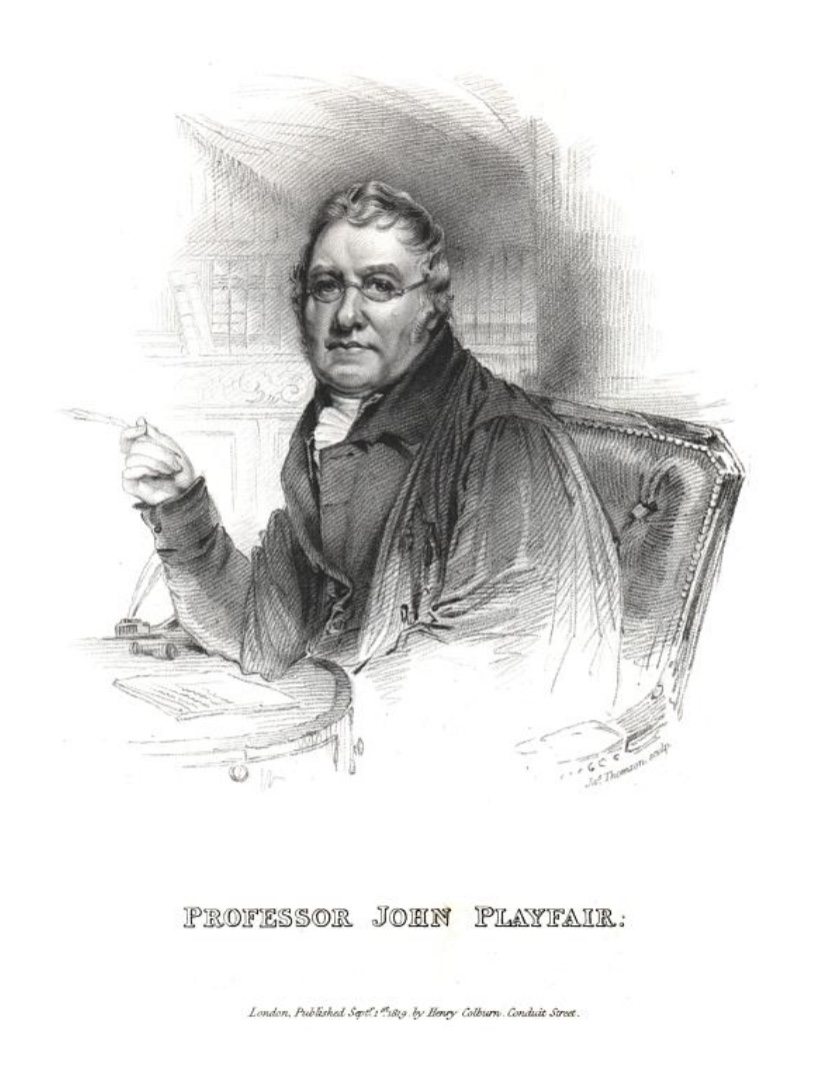- About MAA
- Membership
- MAA Publications
- Periodicals
- Blogs
- MAA Book Series
- MAA Press (an imprint of the AMS)
- MAA Notes
- MAA Reviews
- Mathematical Communication
- Information for Libraries
- Author Resources
- Advertise with MAA
- Meetings
- Competitions
- Programs
- Communities
- MAA Sections
- SIGMAA
- MAA Connect
- Students
- MAA Awards
- Awards Booklets
- Writing Awards
- Teaching Awards
- Service Awards
- Research Awards
- Lecture Awards
- Putnam Competition Individual and Team Winners
- D. E. Shaw Group AMC 8 Awards & Certificates
- Maryam Mirzakhani AMC 10 A Awards & Certificates
- Two Sigma AMC 10 B Awards & Certificates
- Jane Street AMC 12 A Awards & Certificates
- Akamai AMC 12 B Awards & Certificates
- High School Teachers
- News
You are here
Teaching Mathematics with Ephemera: Who Was John Playfair?

John Playfair in 1819. A print engraving by American mathematics textbook publisher James Thomson (1789–1850), based on an etching made by William Nicholson. Courtesy of Scientific Identity Collection, Dibner Library, Smithsonian Institution Libraries, Washington, DC.
John Playfair (1748–1819) is best known among mathematicians for his 1795 textbook, Elements of Geometry, and among historians of science as one of the founders of geology as a formal discipline. He was born on March 10, 1748, in Liff and Benvie, Scotland, the eldest son of what eventually was seven siblings who lived to adulthood. His father was the Church of Scotland minister in these parishes. Playfair matriculated at the University of St. Andrews in 1762, filling in for the ailing natural philosophy professor while still a student and graduating M.A. in 1765. He remained in St. Andrews long enough to qualify for licensure as clergy in 1770. He became financially responsible for his family when his father died in 1772, and he succeeded his father as minister to Liff and Benvie in 1773 (Ackerberg-Hastings, 2005).
Even though his religious and family duties were time-consuming, Playfair was simultaneously making himself known to Scotland's intellectuals—this period of the late Scottish Enlightenment was an era of great energy in the areas of natural and moral philosophy as well as a time of preparation for industrial take-off (Daiches, Jones, and Jones, 1986; Buchan, 2003). In 1774, he assisted Astronomer Royal Nevil Maskelyne with observations on a nearby mountain, Schehallion. Maskelyne sponsored Playfair's first scientific paper, "On the Arithmetic of Impossible Quantities," which was delivered to the Royal Society of London in 1778. Playfair resigned his parishes in 1782 when he was hired to tutor aristocratic brothers who would grow up to be Member of Parliament Robert Ferguson and General Sir Ronald Craufurd Ferguson. This position both better matched his abilities and allowed him more time to pursue his interests. In 1783, he became a founding member of the Royal Society of Edinburgh. In 1785, he finally was appointed to one of the few academic positions in mathematics in the United Kingdom, Joint Professor of Mathematics at the University of Edinburgh.
Playfair began publishing in Transactions of the Royal Society of Edinburgh in 1788, completing six articles before he became the journal's editor in 1798, succeeding John Robison. He wrote eight more articles during his term. His first book was 1795's Elements of Geometry, a textbook designed to update Robert Simson's 1756 The Elements of Euclid. A close friend of James Hutton, in 1802 he completed an explanation and expansion of Hutton's ideas (including the great age of the earth, the belief that most changes in geological structures were caused by heat, and the very slow—or "uniformitarian"—rate of those changes) that was published as Illustrations of the Huttonian Theory of the Earth. In 1804, Playfair began to contribute to Edinburgh Review, a new journal that quickly became famous for its Whiggish politics. Because the articles were unsigned, there is no definitive count of those that can be attributed to Playfair. He is the likely author of about 60 pieces. His submissions were often as much general essays about the state of mathematics, natural philosophy, scholarship on India, women writers, and other topics, as they were detailed examinations of the books they ostensibly reviewed (Ackerberg-Hastings, 2008). Playfair wrote one more textbook, the two-volume Outlines of Natural Philosophy, which appeared in 1812 and 1814. His final major publication summarized his understanding of the history of science in Europe, "Dissertation Second: On the Progress of Mathematical and Physical Science Since the Revival of Letters in Europe," which appeared in a supplement to Encyclopaedia Britannica in 1816. He was ill for a number of months before he died at home in Burntisland in Fife on July 19, 1819.
Playfair never married nor fathered children, but his mother and sisters remained in his household throughout his lifetime. After his brother James, an architect, died in 1794, Playfair saw to the education of James's sons, James and William Henry. William Henry Playfair followed his father to become a prominent architect, designing much of Edinburgh's "New Town" as well as the monument to Playfair that stands on Calton Hill. The descendants of another brother, Robert, apparently ended up in Canada, while a third brother, William, was notoriously mixed up in multiple careers and schemes but found time to invent graphical methods in statistics (Playfair, 2005).
Amy Ackerberg-Hastings (Independent Scholar), "Teaching Mathematics with Ephemera: Who Was John Playfair?," Convergence (April 2019)




